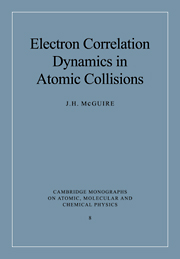Book contents
- Frontmatter
- Contents
- Preface
- 1 Introduction
- 2 Single electron transition probabilities
- 3 Formulation of multi-electron transition probabilities
- 4 Independent electron approximation
- 5 Statistical methods
- 6 Correlated multi-electron electron transition probabilities
- 7 Perturbation expansions
- 8 Projectiles carrying electrons
- 9 Reactions with photons
- 10 Relations between charged particle and photon reactions
- Appendices
- References
- Index
6 - Correlated multi-electron electron transition probabilities
Published online by Cambridge University Press: 11 September 2009
- Frontmatter
- Contents
- Preface
- 1 Introduction
- 2 Single electron transition probabilities
- 3 Formulation of multi-electron transition probabilities
- 4 Independent electron approximation
- 5 Statistical methods
- 6 Correlated multi-electron electron transition probabilities
- 7 Perturbation expansions
- 8 Projectiles carrying electrons
- 9 Reactions with photons
- 10 Relations between charged particle and photon reactions
- Appendices
- References
- Index
Summary
Correlation
There is a significant difference between complex and merely large. This difference is related to the the notion of correlation which defines the rules of interdependency in large systems. The relevant question is: how may one make complicated things from simple ones? Biological systems are complex because the atomic and molecular subsystems are correlated. From the point of view of atomic physics correlation in condensed matter, chemistry and biology is determined at least in part by electron correlation in chemical bonds and the complex interdependent structures of electronic densities. Understanding correlation in this broad sense is a major challenge common to most of science and much of technology. This is sometimes referred to as the many body problem. In a general sense correlation is a conceptual bridge from properties of individuals to properties of groups or families.
The concept of correlation arises in many different contexts. ‘Individual’ may mean an individual electron, an individual molecule or in principle an individual person, musical note or ingredient in a recipe. In this book individual refers to electron for the most part. In this case the interaction between individuals is well known, namely l/r12. However, that does not mean that electron correlation is well understood in general. Although much has been done to investigate correlation in various areas of physics, chemistry, statistics, biology and materials science, in many cases little is well understood except in the limit of weak correlation.
- Type
- Chapter
- Information
- Electron Correlation Dynamics in Atomic Collisions , pp. 120 - 143Publisher: Cambridge University PressPrint publication year: 1997

